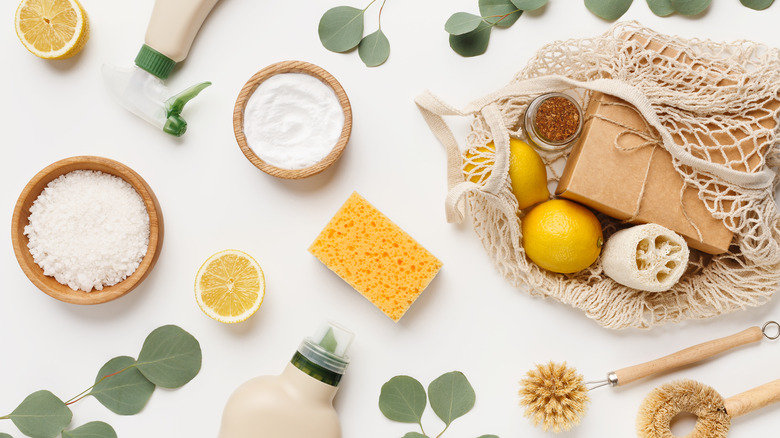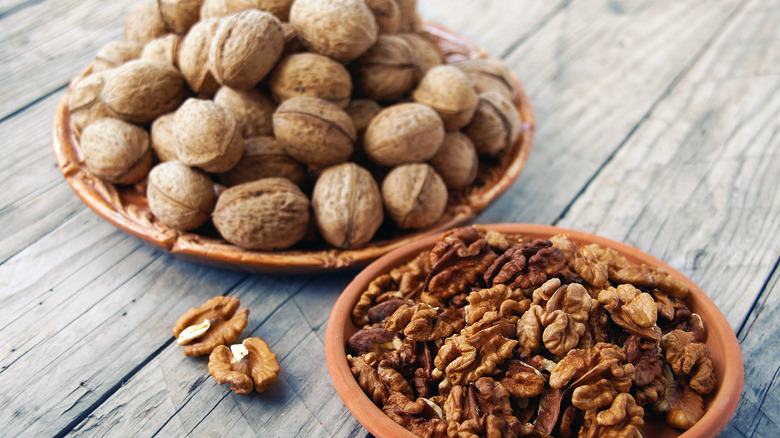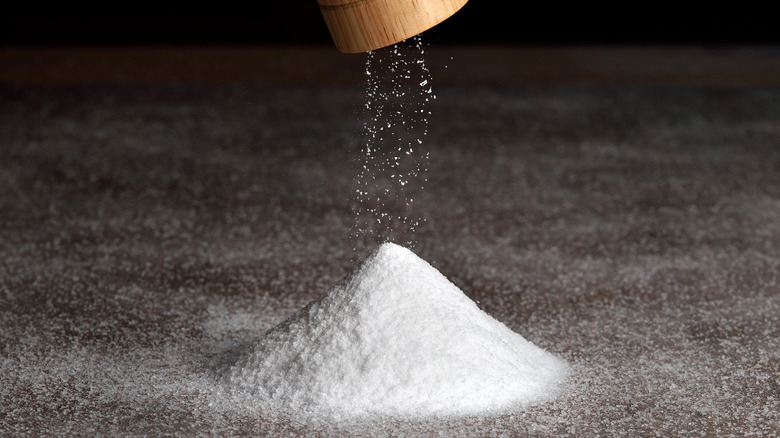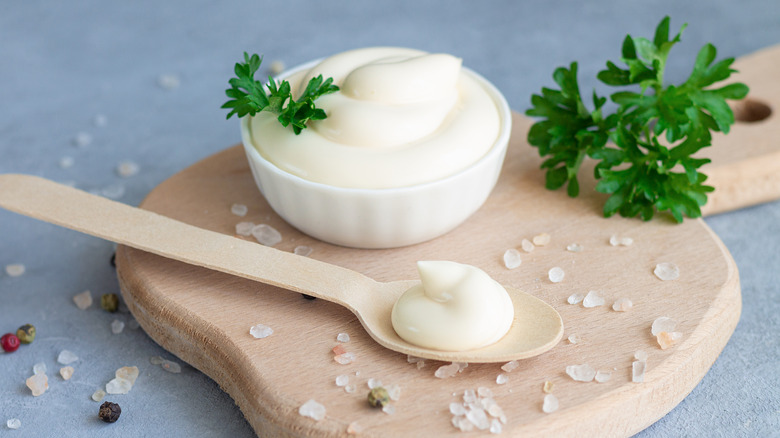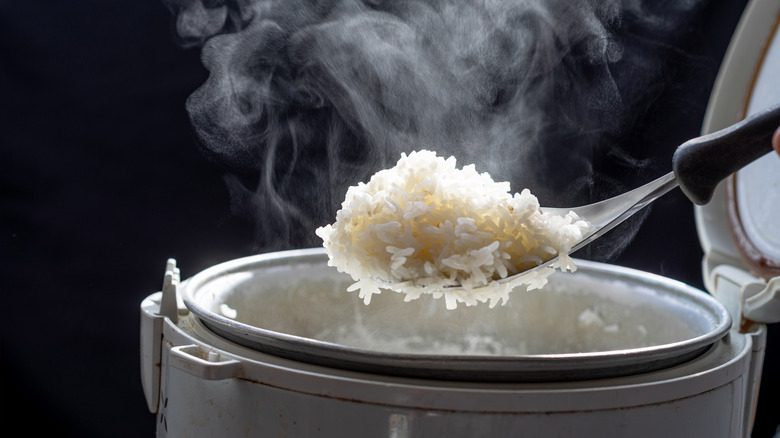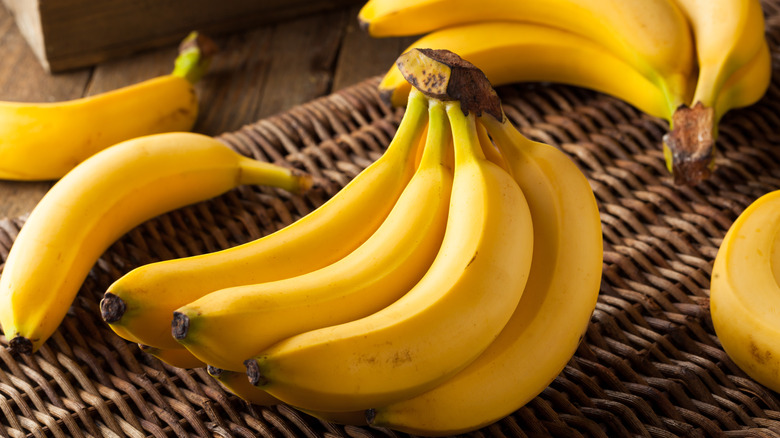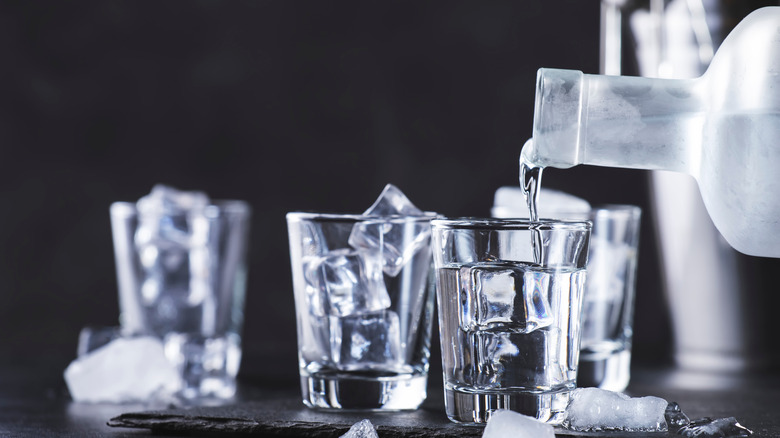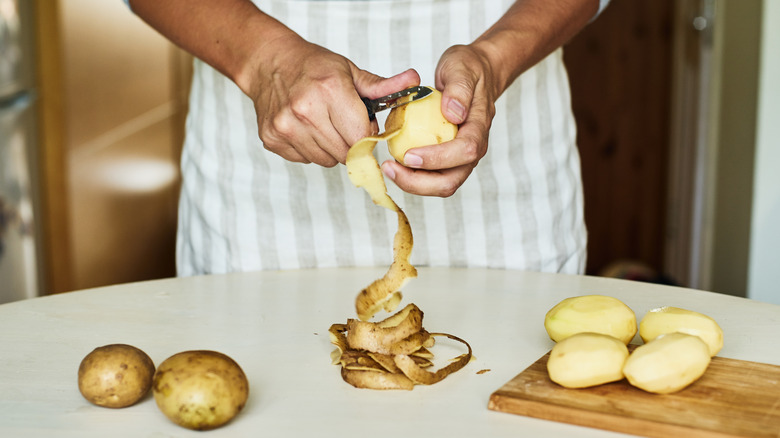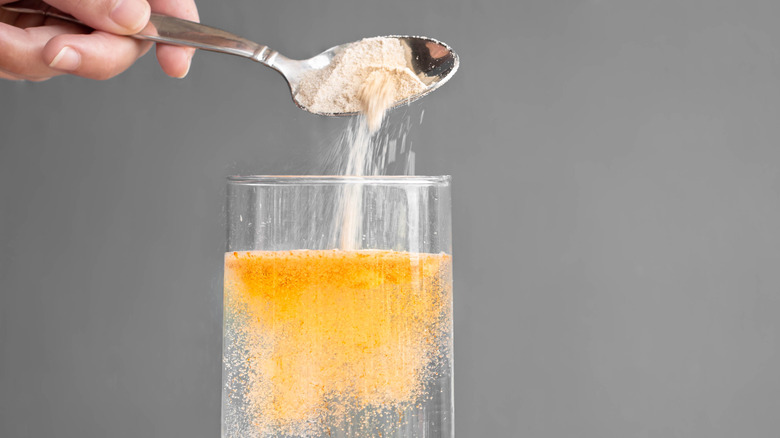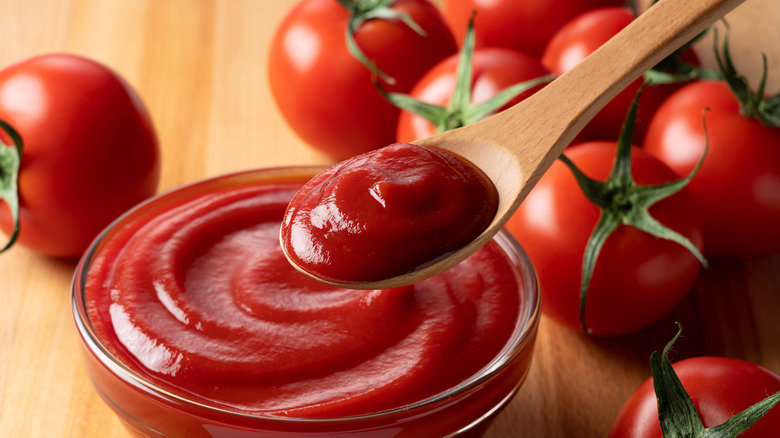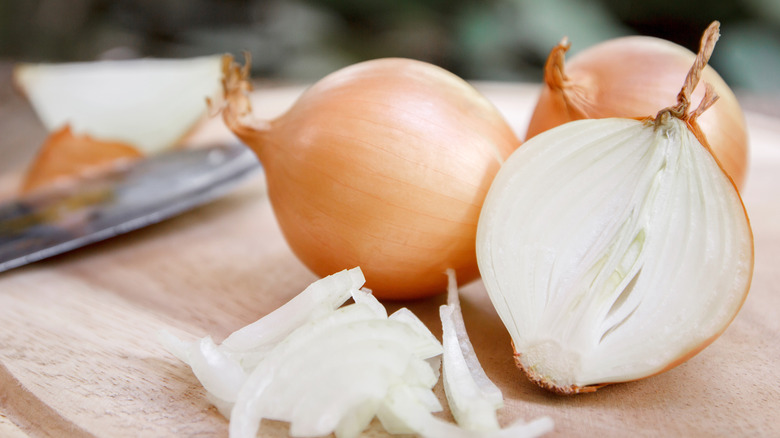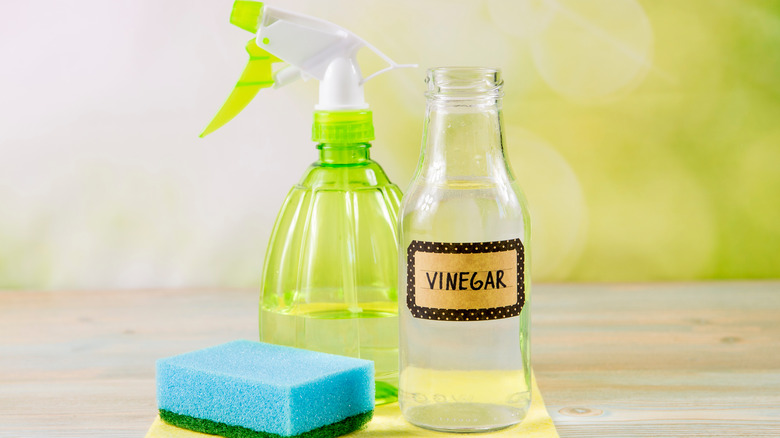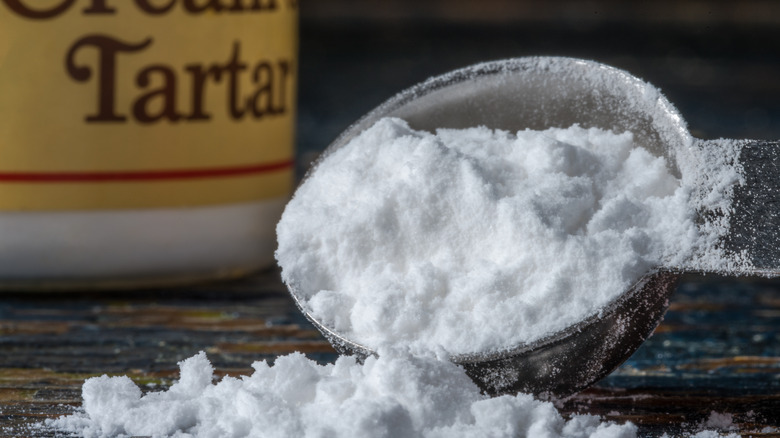Foods You Can Use That Will Actually Clean Your House
When it comes to cleaning, we all have our personal preferences. They're our tried and true hacks, probably passed down from our parents, and involving products and chemicals that we swear work better than anything else. Unfortunately, it's becoming increasingly apparent that our go-to cleaning supplies can be chock full of harsh, toxic chemicals that have negative impacts on our health, our homes, and the world around us.
While some would love to make the switch to more eco-friendly options, it's not always that straightforward. Sometimes, it's more expensive, less effective, or both. Luckily, we may have found a few potential solutions, and they're ones that can't even be found in the cleaning aisle. But they can be found in the grocery store, and they're organic, cheap, and probably sitting in your cabinet, fridge, or pantry right now.
Keep reading to find out what foods you can use to freshen up nearly every room of your house.
Walnuts work wonders on wood
In a viral video originally posted to a "Mums Who Clean" Facebook group for people sharing and searching for cleaning hacks, a woman revealed that her husband all but wrecked their wooden floors while moving their refrigerator. According to this article on The Sun, other members of the group suggested she could clear up the scratch with walnuts. She gave it a go and filmed her results, ultimately showing that walnuts can easily remove unwanted marks from wood.
As shown in the video, the woman rubs the tiny inner pieces of a walnut against the scratches, and they appear to work as a literal eraser. After, she explains that she rubbed the marks again with her finger, followed by a very, very slightly damp cloth. The results are so incredible that it almost seems like magic ... but in reality, the article goes on to explain that the secret ingredient comes from the walnut's natural oils. This is why the real key is to use the inner flesh of a fresh walnut, straight from its shell.
Table salt can basically do it all
Cleaning expert Melissa Maker of Clean My Space revealed that salt is as diverse of a cleaning option as it is eco-friendly. And not fancy Himalayan sea salt, either! Maker's hacks all call for cheap, run-of-the-mill, table salt.
You can mix it with baking soda to scrub your sink clean, or sprinkle it over a cutting board and use one half of a lemon to rub out any stains. You can also shake it out and let it set over a fresh spill on fabric or carpets –– even something as intense as red wine. It also works when cleaning the notoriously tricky cast iron, as well as stainless steel.
If you're looking for new hacks while doing the laundry, consider salt as a stain-removing additive to your laundry cycle, or as a way to clean off any build-up on the outside of your iron. Versatile, cheap, and always on hand: the ultimate cleaning solution.
Mayo is great on sandwiches AND floors
It might sound extremely counterintuitive that anything slightly odorous and with a definite expiration date would be ideal for removing unwanted marks, but according to The Kitchn, it's true. Mayonnaise is apparently a mighty cleaning solution.
Much like walnuts, the popular sandwich spread's oily texture is perfect for removing scuffs and scratches in wooden floors or tables. But unlike walnuts, it requires a bit more patience. According to the experts, this trick works best if you're able to let the mayo sit overnight. But if your patience pays off, in the morning, you'll hopefully be greeted with scuff-free flooring.
The outlet also claims that mayo is great for removing leftover adhesives that get stuck behind when you peel off a label or sticker. The trick is again to let it sit, though this one usually only takes about 20 minutes. For the quickest mayo hack, rub it on stainless steel to instantly remove fingerprints and smudges.
This centuries-old hack makes kitchen clean-up a breeze
In August 2019, blogger and health advocate Sabrina Wang spoke with Apartment Therapy about the wonders of rice water (i.e. the water that's left after boiling rice). Apparently, it's a centuries-old cleaning trick. "This is something that many people in China still do to this day," she said. "Rice is so common there, so instead of wasting the water we use to wash rice, we collect it." This magic rice-making byproduct is apparently perfect for post-cooking clean-up, sorting out everything from dirty dishes to messy countertops to splattered appliances.
Per the outlet, this one works best if you rinse your rice before you cook it. This first step helps remove starch and other minerals from your rice, making it less clumpy and gummy. Then, whatever falls off during the cooking process creates a brilliant cleaning product with a slight abrasion that's akin to scrubbing your surfaces with corn starch. But be warned: it's not a complete cure-all. While it's great for surface cleaning, rice water won't help cut down on your grease. It's just not acidic enough. Instead, use it on your efforts to remove hard water or mild rust stains.
As a bonus tip, use short or long-grained white rice to maximize your starch and create a more acidic rice water, and avoid basmati or brown rice water if you want it to be truly effective.
This tip is BANANAS
Horticulturist Dr. Dave Williams blew our minds twice with this cleaning tip (via SF Gate). Per the expert, banana peels are ideal for dusting houseplants. According to Dr. Williams (via SF Gate), dust on your houseplant's leaves renders them unable to properly absorb sun and create energy via photosynthesis.
While you could spray them down with water (and many people do), this puts your plant babies at risk for mold growth. Instead, he recommends wiping your leaves down with banana peels. You might find that multiple plants will require multiple peels, so prepare to either ingest a lot of potassium on your plant-cleaning day, or plan to make a banana-heavy recipe once you're finished.
If you're thinking this is something you can occasionally add to your to-do list, think again! Dr. Williams recommends wiping down your plants weekly.
Finally, we found a surefire way to have cheap vodka without a hangover
If you've ever thought that cheap vodka smells an awful lot like rubbing alcohol, you might be on to something. Today claims that vodka –– and ideally cheap vodka –– is an excellent disinfectant in a pinch, with a use in nearly every room of the house.
Spray your cheap vodka on mildewy bathroom tiles and let it sit for ten minutes before wiping away, use it to wipe away streaks for shiny mirrors and metal surfaces, or spritz it onto your cutting boards and wash as normal. If you find your mattress is smelling musty, a few spritzes of vodka in a spray bottle should help cut away the odor. The same goes for old shoes, dank closets, and inside your trash can. If replacing one unpleasant smell with another seems like a bad tip, just add a few drops of essential oil and shake before you spray.
Should you decide to toast to your newly sparkling space with a post-cleaning cocktail, consider wiping down your glass with the final few drops for a streak-free salut. Cheers!
This chimney sweep hack is very a-peel-ing
When you envision what it takes to clean a chimney, lots of funny, old-fashioned tools covered in soot probably spring to mind. But according to eHow, one option involves a cookie sheet and some potato peels.
Apparently, each time you light a fire, along with soot, a thick, tar-like substance called creosote collects in your chimney. But never fear, potato peels are a commonly used food option for clearing up creosote! This old wive's tale does have some detractors, but if you're willing to give it a shot, all you need to do is lay out your potato peels on a cookie sheet and let them fully air dry for 24-48 hours. Once they're completely and totally dry, just toss them into the fire and let them burn. As long as they're totally dry, potato peels burn at a high enough energy that it naturally pushes your soot and creosote out.
It is worth noting that regular, professional chimney cleanings are still advised.
Do they have dishwashers in space?
Heidi Schilling Fowler of One Creative Mommy shared a dishwasher cleaning hack that involves Tang, which she traced back to Joe Gagnon, aka "The Appliance Doctor." We're a big fan of dishwasher hacks, but we had no idea that the powdered orange drink favored by astronauts is also a cleaning crew's dream come true.
First, Gagnon via Fowler recommends running your kitchen tap on hot before starting your dishwasher cycle, which they note should be done each and every time. Then, turn off the tap and start your empty dishwasher on a normal cycle. Interrupt the cycle 2-3 minutes in and fill the detergent dispenser with Tang, and empty the rest of the 20 oz. container into the machine. Let the rest of the cycle continue and at the end, your dishwasher should be spotless and your next loads of dishes should be sparkling!
Heidi advises running this gunk-clearing trick about once a month, though after this first deep clean, you probably can get away with just filling the detergent slot rather than dumping a whole container into the bottom.
Ketchup really does go with everything!
Fingerprints, water marks, and rust stains are a huge headache for anyone with steel surfaces. So when a user in the Mrs. Hinch Cleaning Tips Facebook group discovered that ketchup is a surprising way to clean up rusty furniture, her fellow groupies were all ears.
As shared via Metro, Jo Nichol showed before, during, and after photos where she smeared the stained base of a steel kitchen stool with ketchup. Five minutes later, she wiped it off to find a spotless, gleaming surface. While most users were impressed, a few asked the question we're almost afraid to have answered. If that's what ketchup does to metal then what, exactly, is it doing to our insides?
According to Metro, we don't have to worry too much. Ketchup's acetic acid content is fairly high thanks to the fact it's part vinegar. This, along with its thickness, makes it a perfect cleaning agent for shining everything from steel to copper to silverware to brass.
Don't start grilling until you stock up on this must-have veggie
File this one under: wait, what? As arguably the stinkiest vegetable, it's hard to see how onions could be considered a cleaning solution. But according to foodie website Tasting Table, onions aren't just one way to clean your grill post-BBQ ... they're the best way.
Step one is to heat your grill back up so that most of the leftovers burn off. Then, slice your potent produce in half, spear one half of the onion with a fork, and place it face down on the grill. Use the fork to scrape the onion against the grill and let it work its magic as the leftover meat and marinade disappears. Apparently, this hack can be credited to the natural antibacterial properties found in onions, and that's why this one works! If you're using charcoal, you can just toss the leftover onion chunk onto the fire; otherwise, just discard the used bits.
Best of all, thanks to the absence of harsh cleaning chemicals, you don't have to wait to get grilling again.
It's officially time to ditch the fabric softener
Ok, fine, pretty much everybody knows by now that vinegar can be used to clean everything from surfaces to glass to limescale-covered faucets. White vinegar is basically the world's not-so-secret cleaning hack at this point. But did you know that white vinegar can also be used in your laundry cycle?
Per Clean Mama, "Most conventional fabric softeners and dryer sheets are not only toxic, but they also coat fibers making clothes and towels harder to clean because they build up with fabric softener." Fabric softener can also renders towels less useful, make fabric more flammable, and is full of micoplastics that aren't great for environment. But if you feel like removing fabric softener makes for crunchier, less fresh-scented clothes, vinegar might be your solution. Simply add a quarter cup of vinegar into your machine's dispenser or into a fabric softener ball and it should do the trick.
Bonus: the addition of white vinegar should also freshen up your washing machine throughout the cycle.
Who knew Cream of Tartar was so versatile?
Cream of Tartar is a pretty standard pantry staple, but it turns out, there's a lot we didn't know about it. It's not just some random powder you occasionally spot in a baking recipe and wonder if you have any. According to the experts over at The Kitchn, it's actually an acidic byproduct of the wine-making process!
The Kitchn team also claims that Cream of Tartar is great for cleaning all kinds of things, and particularly metals. When used with a wet cloth, it's perfect for spot cleaning stainless steel or removing scratches from dishes. Sprinkle some in warm water, and it can also be used to brighten up dingy kitchen linens, as long as you let them soak overnight. But when mixed with hydrogen peroxide, lemon juice, or both, Cream of Tartar really shows its mettle, pun intended. Combined with the aforementioned ingredients, the powdery substance creates a paste that can be used to clean aluminum pans, copper pots, brass candlesticks, or rusty kitchen tools.
When it comes to foods that double as cleaning agents, it seems like the best bet is to try a few different methods and see what works the best. Fortunately, these inexpensive, easy-to-find, and eco-friendly alternatives to harsh chemicals are likely already in your own home, so give 'em a test run and see how you fare!
